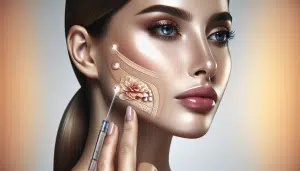Unlocking Smoother Skin Secrets You Might Not Expect
Charlotte Stone September 27, 2025
Embark on a journey to discover smoother, radiant skin with science-backed habits and new treatments. This guide unpacks expert insights and trending wellness strategies focusing on skin rejuvenation, hydration routines, and mindful beauty rituals—helping many enhance their daily glow while understanding the factors that truly shape healthy skin.
Building the Foundation for Radiant Skin Health
Glowing skin begins long before any product touches the surface. Daily routines and lifestyle choices play a pivotal role in promoting lasting skin health. Diets rich in antioxidants, hydration habits, and sleep hygiene synergize to create a robust foundation for a luminous complexion. Those who consistently consume fruits, vegetables, and omega-3 fats often notice an improvement in skin texture and elasticity because antioxidants help fight free radical damage and support collagen production (Source: https://www.hsph.harvard.edu/nutritionsource/antioxidants/).
Equally essential is hydration. Water intake is frequently credited for its impact on skin suppleness and resilience. Dehydrated skin tends to look dull, and fine lines may appear more pronounced. While topical moisturizers lock in external hydration, internal water consumption fuels the deeper layers of the skin. Mindful drinking habits, such as sipping water throughout the day rather than waiting for thirst cues, can help sustain hydration for a naturally dewy appearance.
Sleep also plays a silent yet powerful role. During deep rest, the body repairs itself—including skin cells. Those obtaining seven to nine hours nightly generally report noticeably brighter and more refreshed skin. Sleep deprivation can exacerbate conditions like under-eye circles and uneven tone, making restful slumber a non-negotiable pillar in the pursuit of healthy, glowing skin.
The Science Behind Skin Rejuvenation Techniques
Modern skin rejuvenation encompasses a spectrum of treatments—many of which harness innovative technologies for smoother textures and balanced tone. Popular modalities include microdermabrasion, laser resurfacing, and microneedling. These procedures target the epidermis and dermis, stimulating collagen synthesis and promoting cellular turnover. Collagen, the structural protein responsible for skin firmness, naturally declines with age, so stimulating its production helps maintain youthful features (Source: https://www.aad.org/public/cosmetic/fillers/collagen).
Microneedling, for instance, involves controlled micro-injuries to the skin, triggering the body’s natural healing process. This can lead to improved scarring, texture, and fine lines over time. While clinical treatments offer dramatic changes, at-home devices and topical retinoids can also provide incremental improvements for those seeking gentle, progressive results. Consistent use of sun protection is crucial, as UV damage not only accelerates aging but can interfere with healing after rejuvenation procedures.
For individuals hesitant about clinical interventions, gentle exfoliation and regular application of broad-spectrum sunscreen remain cornerstones in maintaining skin radiance. Ingredients such as glycolic acid and vitamin C serums support surface renewal and even skin tone—making complex procedures optional rather than essential for those dedicated to their daily wellness routine.
Hydration Rituals Transforming Skin Quality
Hydrators and moisturizers have undergone impressive advancements, offering tailored solutions for every skin type and goal. Humectants like hyaluronic acid draw water into the skin, delivering a plumper and more renewed look. Occlusives, on the other hand, form a protective barrier atop the surface, sealing in moisture and shielding the skin from environmental aggressors. Applying these products to damp skin can enhance their absorption and effectiveness (Source: https://www.ncbi.nlm.nih.gov/pmc/articles/PMC5796020/).
Daily hydration routines differ based on individual needs. Those living in dry climates benefit from richer creams, while combination or oily skin types may prefer lightweight gels. Layering techniques—starting with essences or serums and finishing with creams—help provide both water-based and oil-based support. This dual-action approach replenishes the skin’s natural barrier and helps reduce sensitivity, redness, or tightness often caused by external stressors.
Nightly rituals can amplify hydration. Using overnight masks or potent serums before bed allows ingredients to work in synergy with the skin’s nocturnal repair cycle. These practices not only foster a calm mindset but measurably improve softness, elasticity, and overall glow by morning. Tweaking hydrating routines seasonally ensures the skin receives adequate care as temperatures—and ambient humidity—change throughout the year.
Integrating Mindful Beauty Practices for Lasting Wellness
Mindfulness extends to beauty routines, elevating simple acts into deeply restorative experiences. Approaching skincare with intention—such as massaging in creams or pausing to notice textures and sensations—can transform everyday habits. These rituals cut through daily stress and encourage the production of endorphins, which contribute to a healthy glow from within (Source: https://www.apa.org/news/press/releases/2012/11/skin-health).
Modern wellness strategies often merge meditation techniques, such as deep breathing or grounding exercises, into skincare routines. Practitioners find that these elements cultivate a sense of balance and reduce cortisol levels, mitigating flare-ups or sensitivities related to stress. Regularly carving out dedicated moments for mindful skincare can complement even the most advanced science-backed treatments, yielding benefits that extend far beyond what’s visible on the surface.
Community-based beauty workshops, virtual self-care meetups, and online tutorials increasingly foster shared learning. Through these avenues, individuals can explore new skincare ingredients, techniques, and philosophies. By blending scientific knowledge with personalized rituals, many achieve not only smoother and healthier skin, but also a renewed sense of confidence and self-connection—hallmarks of holistic wellness.
Exploring Natural Skincare Ingredients and Their Effects
Interest in natural skincare ingredients continues to rise, with botanicals like aloe vera, chamomile, and green tea leading the conversation. These components boast antioxidant and calming properties, supporting skin that feels balanced and looks luminous. Aloe’s soothing effects benefit those with sensitive or irritated complexions, while green tea polyphenols offer potent protection against free radicals (Source: https://www.ncbi.nlm.nih.gov/pmc/articles/PMC6017965/).
Certain plant-based oils—such as argan, jojoba, and rosehip—are celebrated for their capacity to mimic the skin’s natural sebum. When incorporated wisely, they rebalance oil production, soften texture, and help restore the skin barrier. Organic or cold-pressed varieties tend to retain more nutrients, making them favorites among ingredient-conscious enthusiasts. Patch testing and gradual introduction are recommended when exploring new botanicals to monitor for sensitivities.
Scientific research suggests many natural substances offer real advantages, yet sourcing and formulation quality are critical. Reading product labels, seeking out third-party certifications, and consulting dermatologists or accredited sources ensures the safest and most effective use. Integrating nature-inspired ingredients into a wider beauty regimen provides a gentle and sustainable route toward smoother, more resilient skin.
Adapting Routines for Different Life Stages and Seasons
Skin needs shift with age, climate, and changing routines. Teenagers may focus on oil control and gentle cleansing, while adults gravitate toward targeted actives for fine lines, pigmentation, or firmness. Seasonal shifts—such as increased humidity or winter dryness—also call for updates, like richer creams or lighter serums designed to harmonize with environmental demands (Source: https://www.aad.org/public/everyday-care/skin-care-secrets/routine/change-with-age).
Pregnancy, menopause, or medical treatments can further influence skin behavior. Consulting a healthcare provider when adopting new wellness routines during such transitions ensures both efficacy and safety. Many find that embracing simple, gentle products throughout these times helps maintain skin comfort and radiance without triggering sensitivities.
Others find that tracking specific changes—such as switching out a night cream or adjusting cleansing habits according to the weather—results in fewer flare-ups and improved resilience. Documenting what works (and what doesn’t) facilitates a journey of self-discovery that celebrates individuality, allowing each person to curate a customized wellness routine reflecting their unique needs and lifestyle.
References
1. Harvard T.H. Chan School of Public Health. (n.d.). Antioxidants: Beyond the Hype. Retrieved from https://www.hsph.harvard.edu/nutritionsource/antioxidants/
2. American Academy of Dermatology Association. (n.d.). Collagen Fillers. Retrieved from https://www.aad.org/public/cosmetic/fillers/collagen
3. Lodén, M. (2012). The Clinical Benefit of Moisturizing Products in the Treatment of Dry Skin. Retrieved from https://www.ncbi.nlm.nih.gov/pmc/articles/PMC5796020/
4. American Psychological Association. (2012). The Connection Between Skin and Mind. Retrieved from https://www.apa.org/news/press/releases/2012/11/skin-health
5. Draelos, Z.D. (2018). Botanical Antioxidants in Dermatology: A Review. Retrieved from https://www.ncbi.nlm.nih.gov/pmc/articles/PMC6017965/
6. American Academy of Dermatology Association. (n.d.). Change your Skin Care Routine with Age. Retrieved from https://www.aad.org/public/everyday-care/skin-care-secrets/routine/change-with-age







